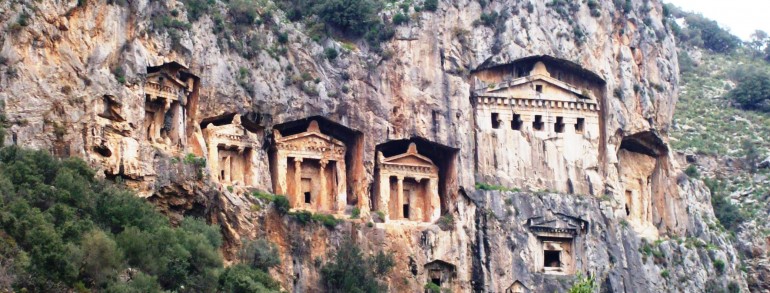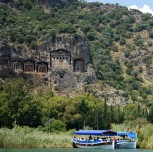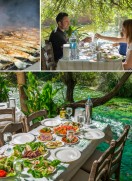This is the nearest ‘major’ trip from Akyaka, being only about an hour away. The prime sites here are the delta itself, with the famous Carian rock tombs (which rather put Akyaka’s to shame!), the ancient city of Kaunos, the mud baths and sulphur springs, the massive freshwater lake at Koycegiz, and the famous Iztuzu (Turtle) beach.
There are many organised trips to Dalyan which will take in all these, my own view is you should do it yourself, and just pick out your favourites – my own are the delta and Kaunos.
If you do plan to visit on your own, you still have to get a boat. These are all available for hire at the harbour in Dalyan, which has a car park virtually next door - there are usually plenty just sitting there waiting , and you can negotiate with the boat owner which sites you wish to visit, and how long you want to spend at each, which is particularly relevant at Kaunos. I believe that all the boats are part of a co-operative, which means that there is pretty much a fixed price, so don’t bother going from boat to boat looking for the best price.
The full blown trip starts off at the harbour, takes in the mud baths, goes to the freshwater lake at Koycegiz, back down the delta past the rock tombs, drops you at one end of Kaunos, picks you up at the other and then goes on to the beach. This really is a full day – and do bear in mind that as the beach is a conservation area (due to the turtles), there are no buildings allowed, and hence no cafes – so stock up either in Dalyan before you leave, or at one of the cafes at either end of Kaunos.
The Mud Baths
There are, I believe, a couple of different places for finding mud, one more commercialised than the other (changing huts, etc). Either way, you will be wading through disgusting feeling black mud, which you dig out with your fingers, and smear all over yourself – great for kids, though not sure at what ages girls grow out of this, boys of course never do.
The idea is that the mud has healing properties for all sorts of skin complaints. So at the very least, you let the mud dry, which does not take very long in the baking sun, before washing it off. The theory is that the longer you leave it on the better for your skin (and of course it is a lot cheaper than whatever you bought at the airport on your way through!).
A word of caution. Although as tourists we are probably doing this for fun, there will be people there who are treating it almost as a religious pilgrimage, to try to cure fairly serious skin problems, and possibly even camping there – so please be sensitive.
Koycegiz
Is a massive indoor lake. Very cold, very clear, very deep, and makes you feel as if you have at least washed off all the mud, sulphur, etc. A lovely refreshing swim – not much more you can say!
The Carian Rock Tombs
As the boat heads back down the delta, on the right hand side half way up the cliffs are a number of stunning 4th century Carian rock tombs, of various sizes, and in various states of repair.
You will almost certainly have seen pictures of these, if not before, on every postcard in every shop in Dalyan! Nevertheless, they are spectacular, and almost look like a family of temples cut into the rocks. You may well find that you take many many photos here, as the view just seems to get better and better as the boat makes its slow way past. I am not sure if it is possible to actually reach the tombs themselves – if it is, it could only be on foot, and would be a fairly hazardous climb!
Kaunos
Shortly after the tombs, the boat will dock at what seems to be the middle of nowhere. This is actually the start of the path up to Kaunos (and I mean up – about 10 minutes serious uphill walking, don’t try to push a buggy). Don’t be put off, the walk is well worth it, and there is a café at the entrance to Kaunos, where you can have a drink, eat an ice cream, use the toilets, and admire the stunning view over Kaunos, with the delta beyond.
The system here is that the boatman (I keep wanting to say driver, but I know that’s not right!) will expect to drop you off at the entrance, and then pick you up some time later at the exit. So this is decision time – he will ask what time you want picking up at the exit. Don’t worry about getting lost, it is a fairly straightforward walk down through Kaunos. The bare minimum would be an hour, 2 hours would allow some exploration and relaxation, 3 hours would probably not be excessive, depending on how interested you are in exploring ruins. As there is a café (and more toilets!) at the exit, you can always relax here in the shade and wait for the boat if you are early.
As you sit at the entrance café, way up to your left is the citadel, with fragmentary walls remaining. I would love to go up here, but have never yet found the energy – maybe next year!
Looking out over Kaunos, there are great views of the harbour – and it is very easy to see how it has all silted up, and why what was once a thriving port slowly died.
The earliest settlement here was in the 9th century BC. Although it was originally Carian, it was very closely allied with Xanthos (Lycian), and over the centuries was subject to different rules and different influences, including Greek and Roman.
Although the site is not as spectacular as Ephesus or Aphrodisias, it is still fascinating. And unlike the 2 more famous towns, digging takes place here every August, so it is constantly getting more and more exposed, and in the height of the season you can actually watch (from very close up) some of the archaeology taking place. Interestingly, most Turkish sites appear to have an affinity with a certain country, from where the archaeology is driven. For example, Hierapolis is dug primarily by Italian universities. Kaunos appears to have been adopted by German archaeologists.
The first main structure is of course the theatre. Dating from the 2nd century BC, this is in good condition, and it is very pleasant to sit here, and imagine the scene some 2000 years ago. The view is also stunning. (As an aside – theatres are used to calculate the population of ancient cities – the rule of thumb is that the population of a city was approximately 10 times the capacity of the local theatre).
Other buildings that sit around the top part of the site include a Byzantine church and Roman baths.
Once you have wandered around this plateau at the top, then start on the path down. This will take you to a temple, and an agora, amongst other intriguing half extant structures – like many Turkish sites, it is very frustrating that excavation and restoration does not proceed at a quicker pace, and that our interests do not necessarily coincide with that of the archaeologists.
The upper part of the walk is on the original paved streets, which gives you a wonderful feeling, you are walking the exact same paving stones as people did 2000 years ago, something I suspect you would not be saying about English 21st Century roads!
(I have to declare a personal interest in Kaunos. I visited here the day after my father died some years ago. Somehow, the timelessness of the whole site was incredibly comforting, so the whole place has a very special meaning for me.)
One downside of Kaunos is that it is not particularly well signed – so try if possible to get a guidebook and / or map, else you will spend half your time there trying to work out what things were, which can be very frustrating.
Iztuzu (Turtle) Beach
This is the last stop on the extended tour. It is really only famous for the turtles that nest there, which of course you have no chance of seeing – you may see their tracks in June and July if you are very lucky.
Other than that, it is incredibly windy, which also makes the sea very choppy – quick visit if you must, and then away.
Getting There by Car
From Akyaka, take the Dalaman road for approximately 50km. You will see Dalyan signposted on a brown sign off to your right. Follow this somewhat low grade road for about 10km, and you are in the centre of Dalyan.
Total distance about 60km, allow no more than 1 hour.
Further Details
This article is dedicated to the memory of Reg Robinson, 1924-2000.














